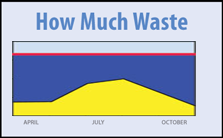Warming Jeopardizes Water Supply
As cold diminishes and snowpacks get lower, Western Canada faces possibility of declining resource.
Four degrees. That's all it will take to completely alter an entire ecosystem that survives and even thrives in the most Canadian of natural environments - snow.
In addition, Western Canada's essential freshwater supply is highly reliant on preserving natural flows of the region's rivers and storage of snow in the upper elevations of our mountains in the form of glacial ice.
The winter season, however, and the cold and snow it brings, has been diminishing in the Northern Hemisphere for several decades, say a trio of this country's top authorities on water, snow and climate change.
And science is only just beginning to uncover the complexities of snow's wide-ranging roles from unique habitat to invaluable freshwater storage mechanism, says John Pomeroy, head of the University of Saskatchewan's hydrology department who bases his research at the University of Calgary's Barrier Lake Field Station in Kananaskis Country, "Not only is snow one of the most beautiful and physically complex natural phenomena, it is the home of many plants and animals, the food source for many more and the provider of water for the alpine summer and for rivers that drain the mountains to provide water to the parched prairies," Pomeroy said.
S now provides habitat for a variety of living creatures on the surface, including ungulates and other mammals and birds, while plants and small mammals live underneath, taking advantage of its insulating qualities.
"On the surface, snow is cold," Pomeroy said. "But the deeper you go in the snow, the hotter it is. If you're a vole, that's a nice, warm place to be."
In addition to familiar mammals and plants, snow also harbours countless lesser-known species, says Bob Sandford, Canadian chair of the UN's Water for Life Decade initiative.
"Snow is a unique environment with its own remarkable hydrological conditions," Sandford said. "Whole ecosystems are known to exist within the wilderness of the nivean world. Some of these ecosystems - those found on glaciers - are among the oldest to exist on Earth.
They are also among the most endangered."
Among those are Collembola, known as springtails or snow fleas. As many as 466 species of microorganisms live in snow, including 77 fungi, 35 bacteria and numerous algae. In the Rockies, the best known cryophiles (creatures that survive at or below water's freezing point) are red algae known as "watermelon snow," which turns snow pink.
Resting spores remain dormant during the summer; some algae retained in their original meltwater have remained viable for 25 years. Some researchers think these organisms can be traced as far back as the period immediately preceding the Cambrian explosion of life represented in the Burgess Shale.
"Glacial ecology is still very much in its pioneering stage," Sandford said. "We could learn much from these organisms. Cold-adapted microorganisms have considerable potential in biotechnological applications as wide ranging as waste treatment at cold temperatures, enzymology, the food industry, medicine and in environmental bioremediation."
But with temperatures warming and glaciers diminishing the world over, these organisms might disappear before some are even discovered, he added.
"It would be a tragedy to lose our psychrophilic ecosystems before we even knew they existed," Sandford said.
Since global observations began in the late 1960s, a 10% reduction in snow-covered area in springtime in the North Hemisphere has been recorded. Over the course of the 20th century, the duration of ice cover in rivers and lakes in Canada's high and middle latitudes decreased by two weeks. Worldwide, glaciers have declined steadily for the past century.
I n the Canadian Rockies alone, as many as 300 glaciers could have been lost between 1920 and 2005. Current projections for the Rockies' Waputik, Wapta, Freshfied, Mons, Lyell and Columbia icefields are not optimistic.
Not just shrinking back, glaciers are thinning and losing volume all around. Even the generous snowfalls of the 2011 spring season didn't help Kananaskis Country's Haig Glacier, said U of C glaciologist Shawn Marshall. By summer's end, all the winter snow had melted, as well as a portion of glacier ice.
"I really thought it might lead to a positive mass balance, but it didn't quite make it," Marshall said.
"By the end of the summer it was a negative year, and we suspect the same on the Peyto Glacier, too. Greenland is weighing less every year. There is a redistribution of mass of the global system taking place."
Beyond habitat and water storage, glacier loss has other consequences. Known as albedo, the occurrence of snow and ice reflecting sunlight back into the atmosphere is also changing. As snow and ice cover shrink, the albedo is lowered, increasing the absorption of solar radiation which in turn increases temperatures, which further reduces snow and ice.
The ability to insulate up to six times more effectively than the equivalent depth of soil, deep snow permits the growing of grain crops such as winter wheat. As well, snow is a reservoir that stores water much the way a dam does for gradual release downstream through the spring and summer.
"There is not enough money in the world to build all the dams that would be required to store all the water that the winter snowpack does for later release into streams and rivers," Sandford said. "Cold provides this invaluable service for free."
Snow also acts as a heat bank which stores and releases energy over time, but researchers have recorded a 40% decrease in the thickness of Arctic sea ice in recent decades.
B ecause it takes 80 times more heat to raise the temperature of ice than it does to raise the temperature of water, it is estimated the loss of northern sea ice will cause as much warming as can be attributed to 70% of the carbon dioxide in the Earth's atmosphere.
Add to that, widespread degradation of permafrost due to rising temperatures is suddenly releasing large volumes of trapped methane into the atmosphere.
Though it does not remain in the atmosphere as long, methane is 24 times more potent a greenhouse gas than carbon dioxide.
"The thresholds at which such changes might occur are among the most troubling unknowns in climate science," Sandford said.
"By warming our climate we have torn open the fixed envelope of certainty within which we anticipated natural phenomena to fluctuate. The genie is out of the bottle causing droughts and floods and general pandemonium widely. The mountain west is in the midst of significant change and glass-floored commercial viewpoints are not going to save us."
That Canadians remain unprepared is a real problem, he says.
"The water security of Western Canada is predicated on the preservation of the natural flows and storage of mountain snow, ice and water," Pomeroy said.
"This water security controls our natural ecosystems and our ability to provide communities, food and energy throughout Western Canada. We risk everything by losing this water security and so must conserve our mountain cold environment."
By Lynn Martel, For Postmedia News


